2015 MERCEDES-BENZ SLS AMG GT COUPE weight
[x] Cancel search: weightPage 8 of 290
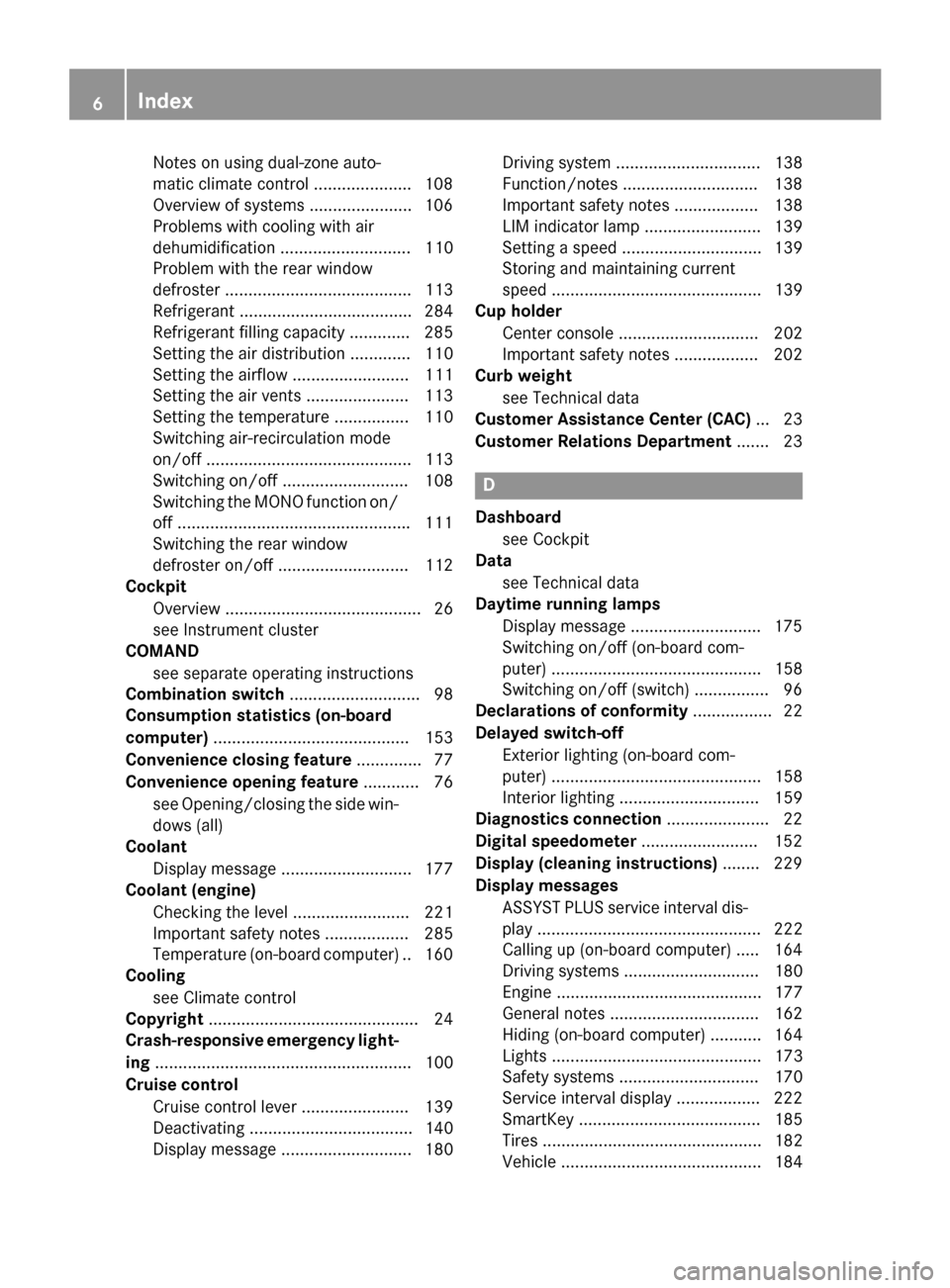
Notes on using dual-zone auto-
matic climate control .....................1
08
Overview of systems ..................... .106
Problems with cooling with air
dehumidification ............................ 110
Problem with the rear window
defroster ........................................ 113
Refrigerant ..................................... 284
Refrigerant filling capacity ............. 285
Setting the aird istribution ............. 110
Setting the airflow ......................... 111
Setting the airv ents ..................... .113
Setting the temperature ................ 110
Switching air-recirculation mode
on/off ............................................ 113
Switching on/off ........................... 108
Switching the MONO function on/
off ................................................. .111
Switching the rear window
defroster on/off ............................ 112
Cockpit
Overview .......................................... 26
see Instrument cluster
COMAND
see separate operating instructions
Combination switch ............................ 98
Consumptio nstatistic s(on -board
computer) .......................................... 153
Convenience closing feature .............. 77
Convenience opening feature ............ 76
see Opening/closing the sid ewin-
dow s(all)
Coolant
Display message ............................ 177
Coolan t(en gine)
Checking the leve l......................... 221
Important safety notes .................. 285
Temperature (on-board computer) .. 160
Cooling
see Climate control
Copyright ............................................. 24
Crash-responsive emergency light-
ing ....................................................... 100
Cruis econtrol
Cruise control leve r....................... 139
Deactivating ................................... 140
Display message ............................ 180 Driving system ............................... 138
Function/notes ............................
.138
Important safety notes .................. 138
LIM indicator lamp ......................... 139
Setting aspee d.............................. 139
Storing and maintaining current
spee d............................................. 139
Cup holder
Center console .............................. 202
Important safety notes .................. 202
Curb weight
see Technical data
Customer Assistanc eCenter (CAC) ... 23
Customer Relations Department ....... 23 D
Dashboard see Cockpit
Data
see Technical data
Daytime runnin glamps
Display message ............................ 175
Switching on/off (on-board com-
puter) ............................................. 158
Switching on/off (switch) ................ 96
Declarations of conformity ................. 22
Delaye dswitch-off
Exterior lighting (on-board com-
puter) ............................................. 158
Interior lighting .............................. 159
Diagnostic sconnection ..................... .22
Digital speedometer .........................152
Display (cleaning instructions) ........229
Display messages ASSYST PLUS service interva ldis-
pla y................................................ 222
Calling up (on-board computer) ..... 164
Driving system s............................. 180
Engine ............................................ 177
Genera lnotes ................................ 162
Hiding (on-board computer) ........... 164
Lights ............................................. 173
Safety systems .............................. 170
Service interva ldisplay .................. 222
SmartKey ....................................... 185
Tires ............................................... 182
Vehicl e........................................... 184 6
Index
Page 16 of 290
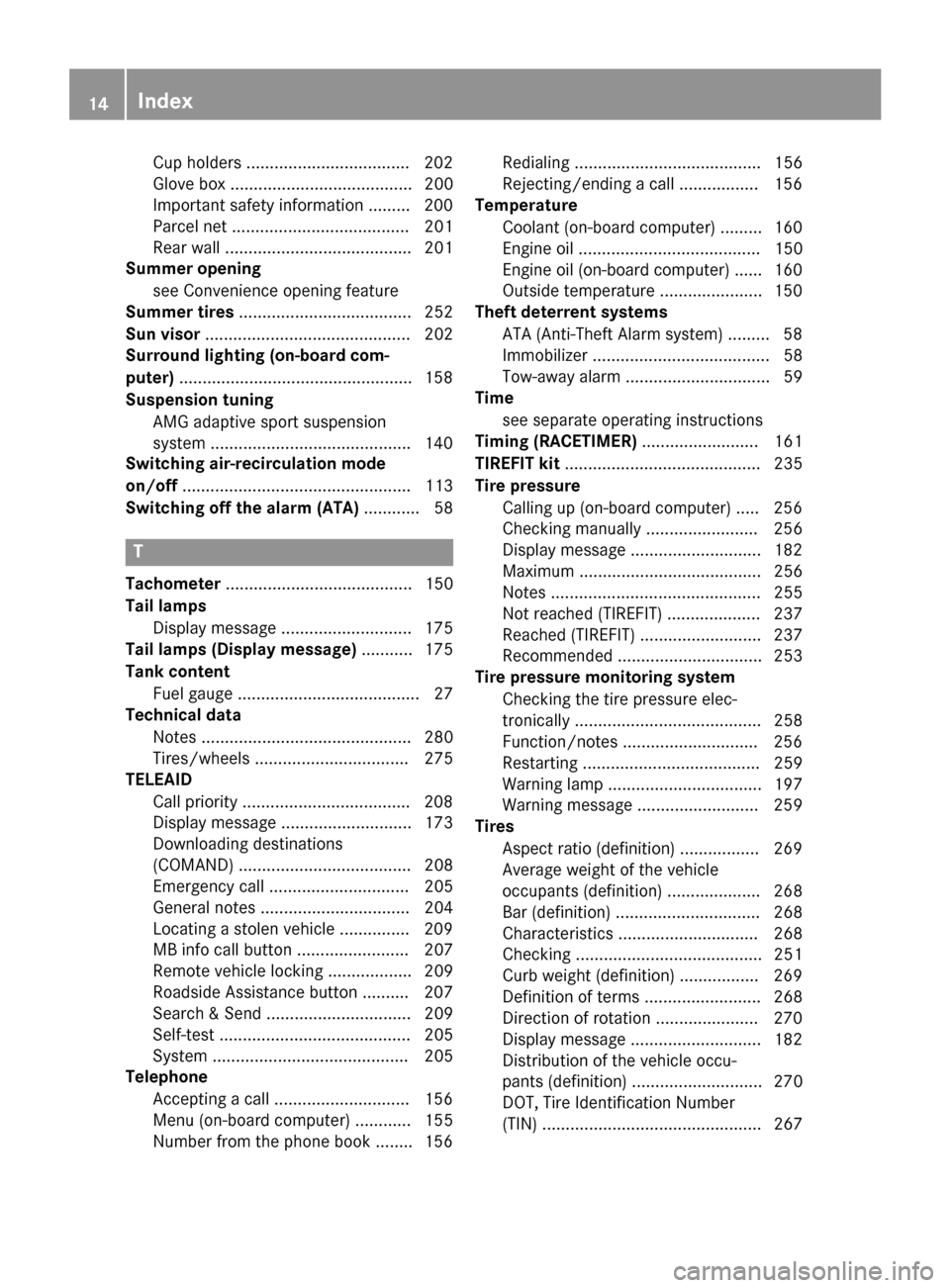
Cup holders ..................................
.202
Glove box ....................................... 200
Important safety information ......... 200
Parce lnet ...................................... 201
Rea rwall. ....................................... 201
Summer opening
see Convenience opening feature
Summer tires ..................................... 252
Sun visor ............................................ 202
Surround lighting (on-board com-
puter) ................................................. .158
Suspensio ntuning
AMG adaptive sport suspension
system .......................................... .140
Switchin gair-recirculation mode
on/off ................................................. 113
Switchin goff the alarm (ATA) ............ 58T
Tachometer ........................................ 150
Tail lamps Display message ............................ 175
Tail lamps (Display message) ........... 175
Tank content Fuel gauge ....................................... 27
Technical data
Notes ............................................. 280
Tires/wheels ................................. 275
TELEAID
Call priority ................................... .208
Display message ............................ 173
Downloading destinations
(COMAND) ..................................... 208
Emergency call .............................. 205
General notes ................................ 204
Locating astole nvehicle .............. .209
MB info call button ........................ 207
Remote vehicle locking .................. 209
Roadside Assistance button .......... 207
Search &Send ............................... 209
Self-test ......................................... 205
System .......................................... 205
Telephone
Accepting acall ............................ .156
Menu (on-board computer) ............ 155
Number from the phone book ....... .156 Redialing ........................................ 156
Rejecting/ending
acall ................. 156
Temperature
Coolant (on-board computer) ......... 160
Engine oil ....................................... 150
Engine oil (on-board computer) ...... 160
Outside temperature ..................... .150
Theft deterren tsystems
ATA (Anti-Theft Alarm system) ......... 58
Immobilize r...................................... 58
Tow-awa yalarm ............................... 59
Time
see separate operating instructions
Timing (RACETIMER) ......................... 161
TIREFIT kit .......................................... 235
Tire pressure Calling up (on-board computer) ..... 256
Checking manually ........................ 256
Display message ............................ 182
Maximum ....................................... 256
Notes ............................................. 255
Not reached (TIREFIT) .................... 237
Reached (TIREFIT) .......................... 237
Recommended ............................... 253
Tire pressure monitoring system
Checking the tire pressure elec-
tronically ........................................ 258
Function/notes ............................ .256
Restarting ...................................... 259
Warning lamp ................................. 197
Warning message .......................... 259
Tires
Aspect ratio (definition) ................. 269
Averag eweight of the vehicle
occupants (definition) .................... 268
Bar (definition) ............................... 268
Characteristics .............................. 268
Checking ........................................ 251
Curb weight (definition) ................. 269
Definition of terms ......................... 268
Direction of rotatio n..................... .270
Display message ............................ 182
Distributio nofthe vehicle occu-
pants (definition) ............................ 270
DOT, Tire Identification Number
(TIN) ............................................... 267 14
Index
Page 17 of 290
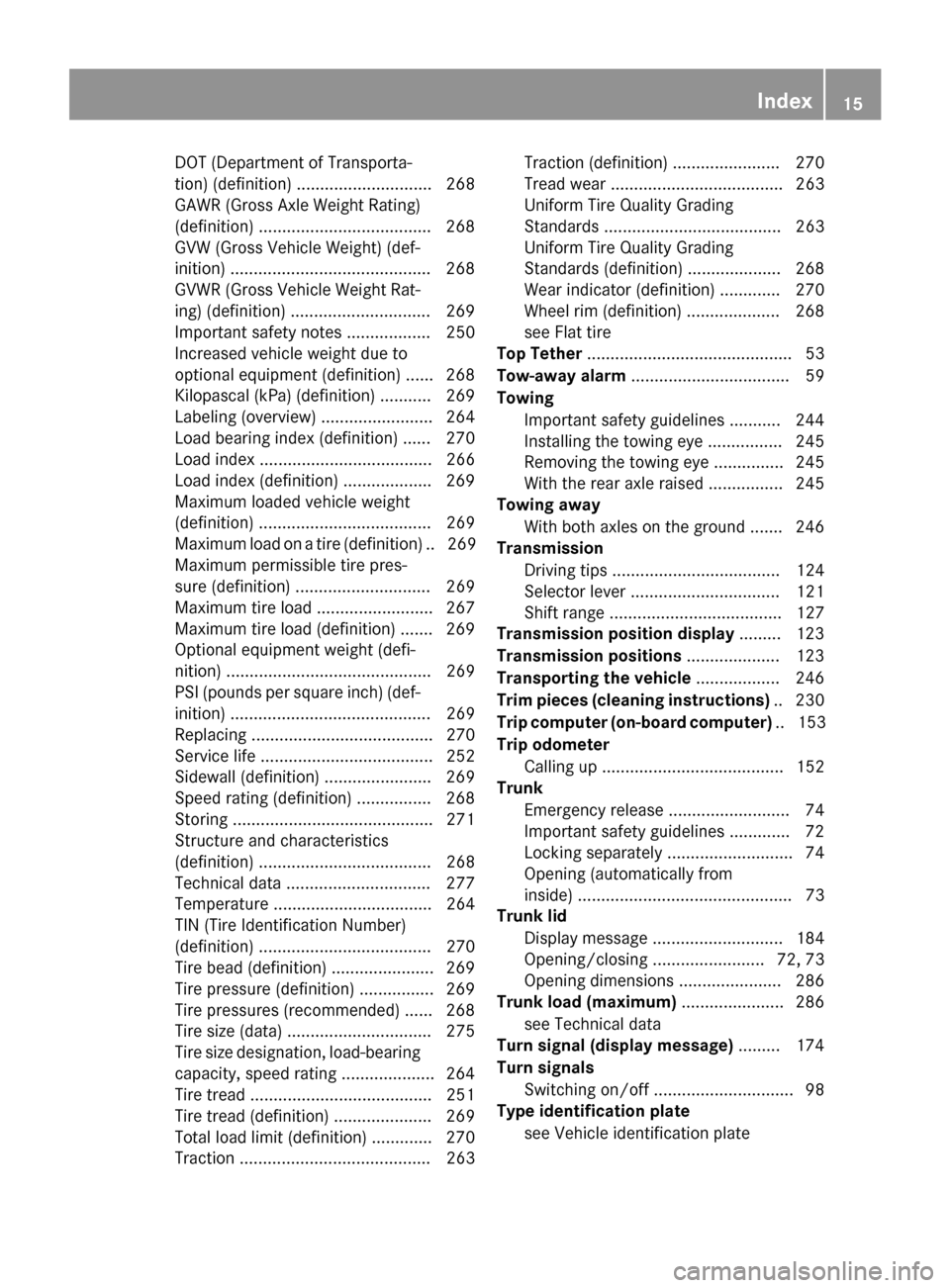
DOT (Department of Transporta-
tion) (definition) ............................. 268
GAW
R(GrossA xle Weight Rating)
(definition) .................................... .268
GVW (Gross Vehicle Weight) (def-
inition) .......................................... .268
GVW R(Gross Vehicle Weight Rat-
ing) (definition) .............................. 269
Important safety notes .................. 250
Increase dvehicle weight due to
optional equipment (definition) ...... 268
Kilopascal (kPa )(definition) ........... 269
Labeling (overview )........................ 264
Loa dbearing index (definition) ...... 270
Loa dindex ..................................... 266
Loa dindex (definition) ................... 269
Maximu mloaded vehicleweight
(definition) ..................................... 269
Maximu mloadona tire (definition) .. 269
Maximu mpermissibl etire pres-
sure (definition) ............................. 269
Maximu mtire load ......................... 267
Maximu mtire load (definition) ....... 269
Optiona lequipment weight (defi-
nition) ............................................ 269
PSI (pounds pe rsquare inch )(de f-
inition) ........................................... 269
Replacing ....................................... 270
Service life ..................................... 252
Sidewal l(de finition) ....................... 269
Speed rating (definition) ................ 268
Storing ........................................... 271
Structure and characteristics
(definition) ..................................... 268
Technica ldata. .............................. 277
Temperature .................................. 264
TIN (Tire Identification Number)
(definition) ..................................... 270
Tire bead (definition) ...................... 269
Tire pressure (definition) ................ 269
Tire pressures (recommended )...... 268
Tire size (data )............................... 275
Tire size designation, load-bearing capacity, speed rating .................... 264
Tire trea d....................................... 251
Tire trea d(definition) ..................... 269
Tota lloa dlim it (definition) ............. 270
Tractio n......................................... 263 Tractio
n(definition) ....................... 270
Tread wear ..................................... 263
Uniform Tire Quality Grading
Standard s...................................... 263
Uniform Tire Quality Grading
Standard s(de finition) .................... 268
Wea rindicator (definition) ............. 270
Wheel rim (definition) .................... 268
see Fla ttire
Top Tether ............................................ 53
Tow-away alarm .................................. 59
Towing Important safety guideline s........... 244
Installing the towing ey e................ 245
Removing the towing ey e............... 245
With the rea raxler aised ................ 245
Towin gaway
With both axles on the ground ....... 246
Transmission
Driving tip s.................................... 124
Selector lever ................................ 121
Shift rang e..................................... 127
Transmissio nposition display ......... 123
Transmissio npositions .................... 123
Transporting the vehicle .................. 246
Trim piece s(clea ning instructions) .. 230
Trip computer (on-board computer) .. 153
Trip odometer Calling up ....................................... 152
Trunk
Emergency release .......................... 74
Important safety guideline s............. 72
Locking separatel y........................... 74
Opening (automatically from
inside ).............................................. 73
Trunk lid
Displa ymessage ............................ 184
Opening/closing ........................ 72, 73
Opening dimensions ...................... 286
Trunk load (maximum) ...................... 286
see Technical data
Turn signal (display message) ......... 174
Turn signals Switching on/of f.............................. 98
Type identificatio nplate
see Vehicl eide ntification plate Index
15
Page 18 of 290
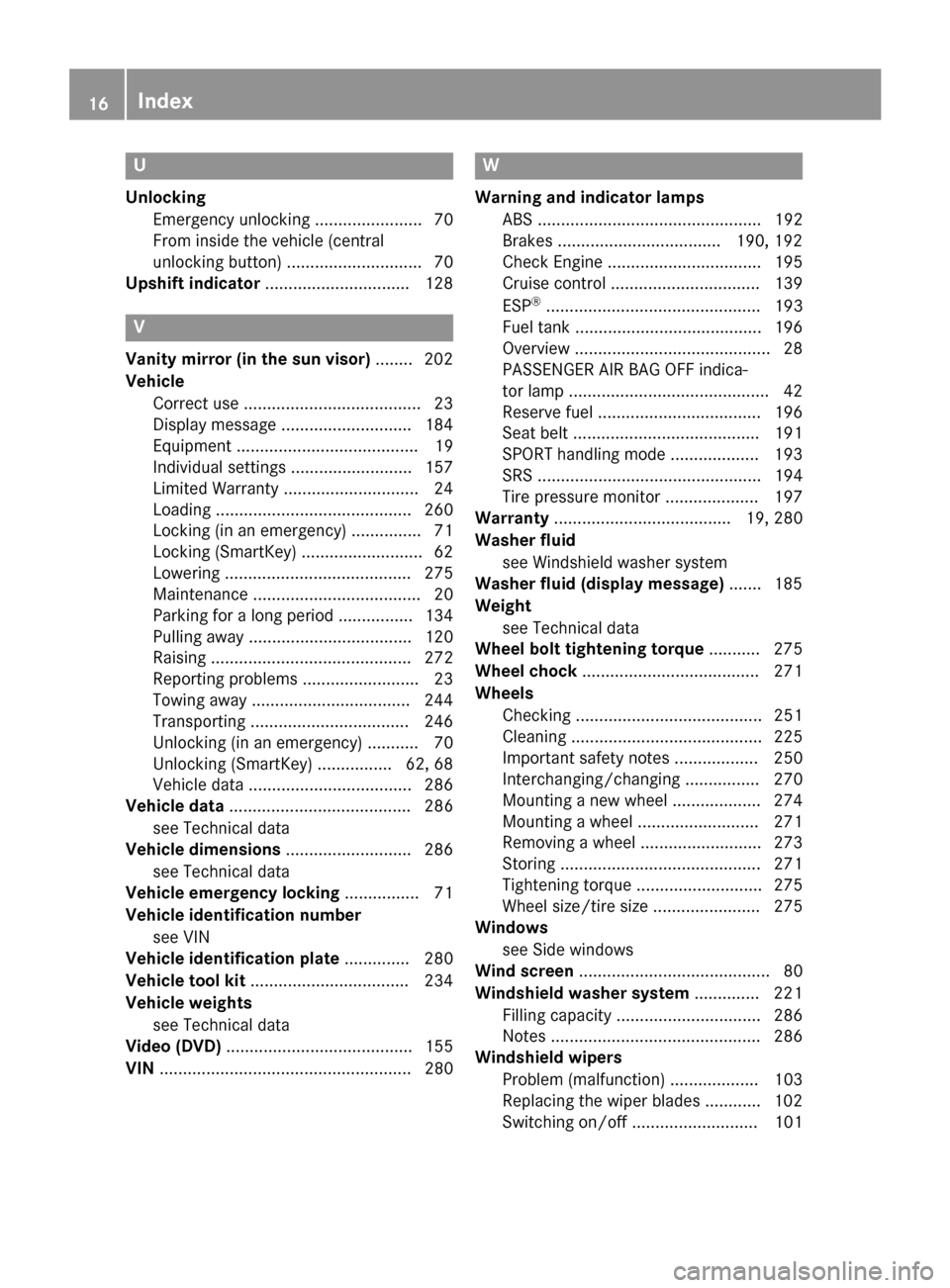
U
Unlocking Emergenc yunlocking .......................70
From inside the vehicle (central
unlocking button) ............................. 70
Upshift indicator ............................... 128V
Vanity mirror (i nthe sun visor) ........ 202
Vehicle Correct us e...................................... 23
Displa ymessag e............................ 184
Equipment ....................................... 19
Individua lsettings .......................... 157
Limite dWarranty ............................. 24
Loading .......................................... 260
Locking (i nanemergency) ............... 71
Locking (SmartKey ).......................... 62
Lowering ........................................ 275
Maintenance .................................... 20
Parking for alon gp eriod. ............... 134
Pulling away ................................... 120
Raising ........................................... 272
Reporting problems ......................... 23
Towing away .................................. 244
Transporting .................................. 246
Unlocking (i nanemergency) ........... 70
Unlocking (SmartKey )................ 62, 68
Vehicl edata. .................................. 286
Vehicl edata ....................................... 286
see Technica ldata
Vehicl edimensions ........................... 286
see Technica ldata
Vehicl eemergenc yloc king ................ 71
Vehicl eidentificatio nnumber
see VIN
Vehicl eidentificatio nplate .............. 280
Vehicl etoolkit.................................. 234
Vehicl eweigh ts
see Technica ldata
Vide o(DV D)........................................ 155
VIN ...................................................... 280 W
Warning and indicator lamps ABS ................................................ 192
Brakes ................................... 190 ,192
Check Engine ................................. 195
Cruise control ................................ 139
ESP ®
.............................................. 193
Fue ltank ........................................ 196
Overview .......................................... 28
PASSENGER AIR BAG OFF indica-
tor lamp ........................................... 42
Reserve fue l................................... 196
Sea tbelt. ....................................... 191
SPOR Thandling mod e................... 193
SRS ................................................ 194
Tire pressure monitor .................... 197
Warranty ...................................... 19, 280
Washer fluid see Windshield washe rsystem
Washer fluid (display message) ....... 185
Weight see Technical data
Wheel bolt tightenin gtorque ........... 275
Wheel chock ...................................... 271
Wheels Checking ........................................ 251
Cleaning ......................................... 225
Important safety notes .................. 250
Interchanging/changing ................ 270
Mounting anew whee l................... 274
Mounting awheel .......................... 271
Removing awheel .......................... 273
Storing ........................................... 271
Tightening torque ........................... 275
Wheel size/tire size ....................... 275
Windows
see Sid ewindows
Win dscreen ......................................... 80
Windshiel dwasher system .............. 221
Filling capacity ............................... 286
Note s............................................. 286
Windshiel dwipers
Problem (malfunction) ................... 103
Replacing the wipe rblade s............ 102
Switching on/of f........................... 101 16
Index
Page 20 of 290
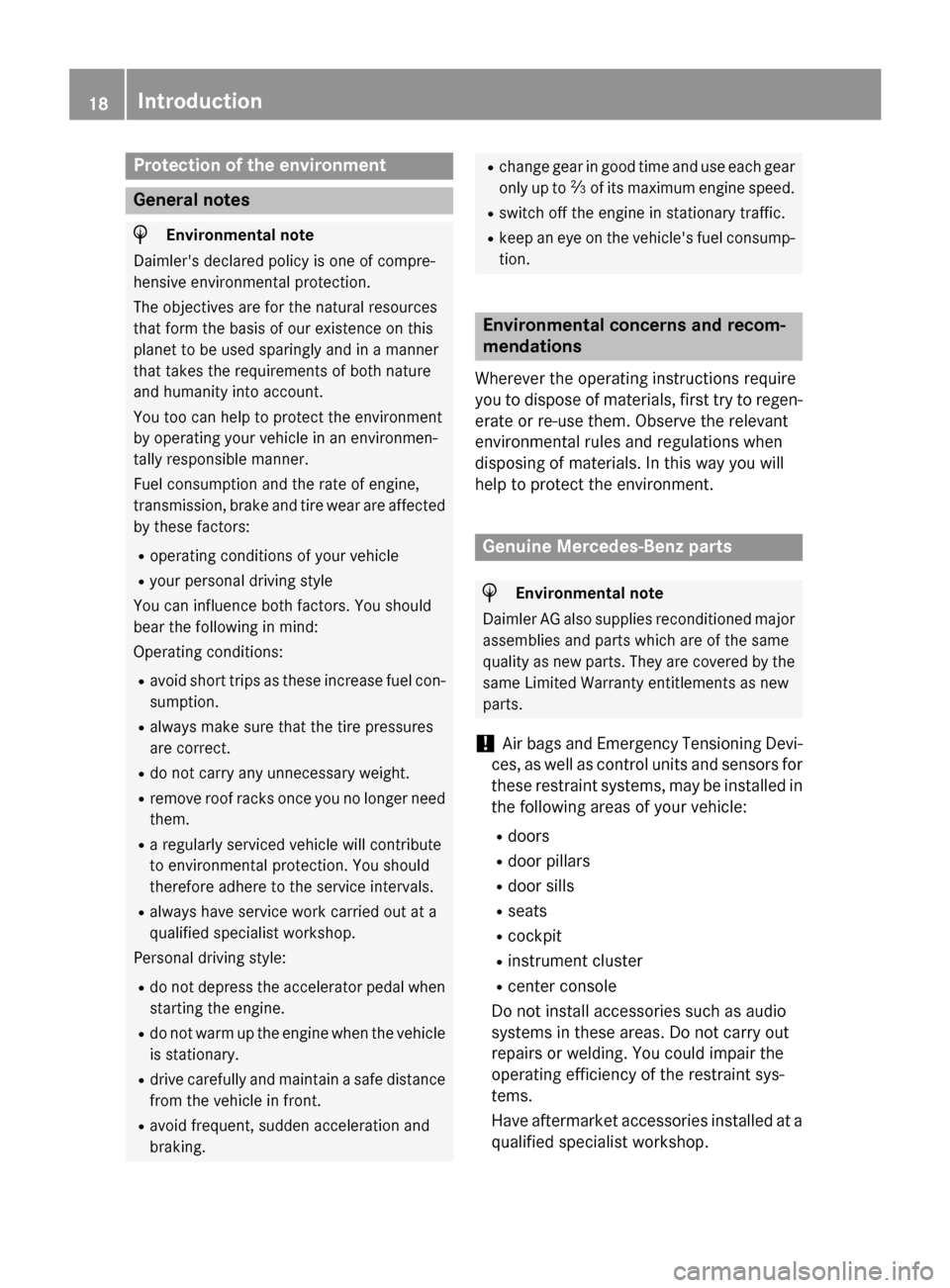
Protection of the environment
General notes
H
Environmental note
Daimler's declared policy is one of compre-
hensive environmental protection.
The objectives are for the natural resources
that form the basis of our existence on this
planet to be used sparingly and in amanner
that takes the requirements of both nature
and humanity into account.
You too can help to protect the environment
by operating your vehicle in an environmen-
tally responsible manner.
Fuel consumption and the rate of engine,
transmission, brake and tire wear are affected by these factors:
R operating condition sofyour vehicle
R your personal driving style
You can influence both factors. You should
bear the following in mind:
Operating conditions:
R avoid short trips as these increase fuel con-
sumption.
R always make sure that the tire pressures
are correct.
R do not carry any unnecessary weight.
R remove roof racks once you no longer need
them.
R ar egularly serviced vehicle will contribute
to environmental protection. You should
therefore adhere to the service intervals.
R always have service work carried out at a
qualified specialist workshop.
Personal driving style:
R do not depress the accelerator pedal when
startingt he engine.
R do not warm up the engine when the vehicle
is stationary.
R drive carefully and maintain asafe distance
from the vehicle in front.
R avoid frequent, sudden acceleration and
braking. R
change gear in good time and use each gear
only up to 00C3of its maximum engine speed.
R switch off the engine in stationary traffic.
R keep an eye on the vehicle's fuel consump-
tion. Environmental concerns and recom-
mendations
Wherever the operating instructions require
you to dispose of materials, first try to regen-
erate or re-use them. Observe the relevant
environmental rules and regulations when
disposing of materials. In this way you will
help to protect the environment. Genuine Mercedes-Benz parts
H
Environmental note
Daimler AG also suppliesr econditioned major
assemblies and parts which are of the same
quality as new parts. They are covered by the same Limited Warranty entitlements as new
parts.
! Air bags and Emergency Tensioning Devi-
ces, as well as control units and sensors for these restraint systems, may be installed inthe following areas of your vehicle:
R doors
R door pillars
R door sills
R seats
R cockpit
R instrumen tcluster
R center console
Do not install accessories such as audio
systems in these areas. Do not carry out
repairs or welding. You could impair the
operating efficienc yofthe restraint sys-
tems.
Have aftermarket accessories installed at a qualified specialist workshop. 18
Introduction
Page 41 of 290
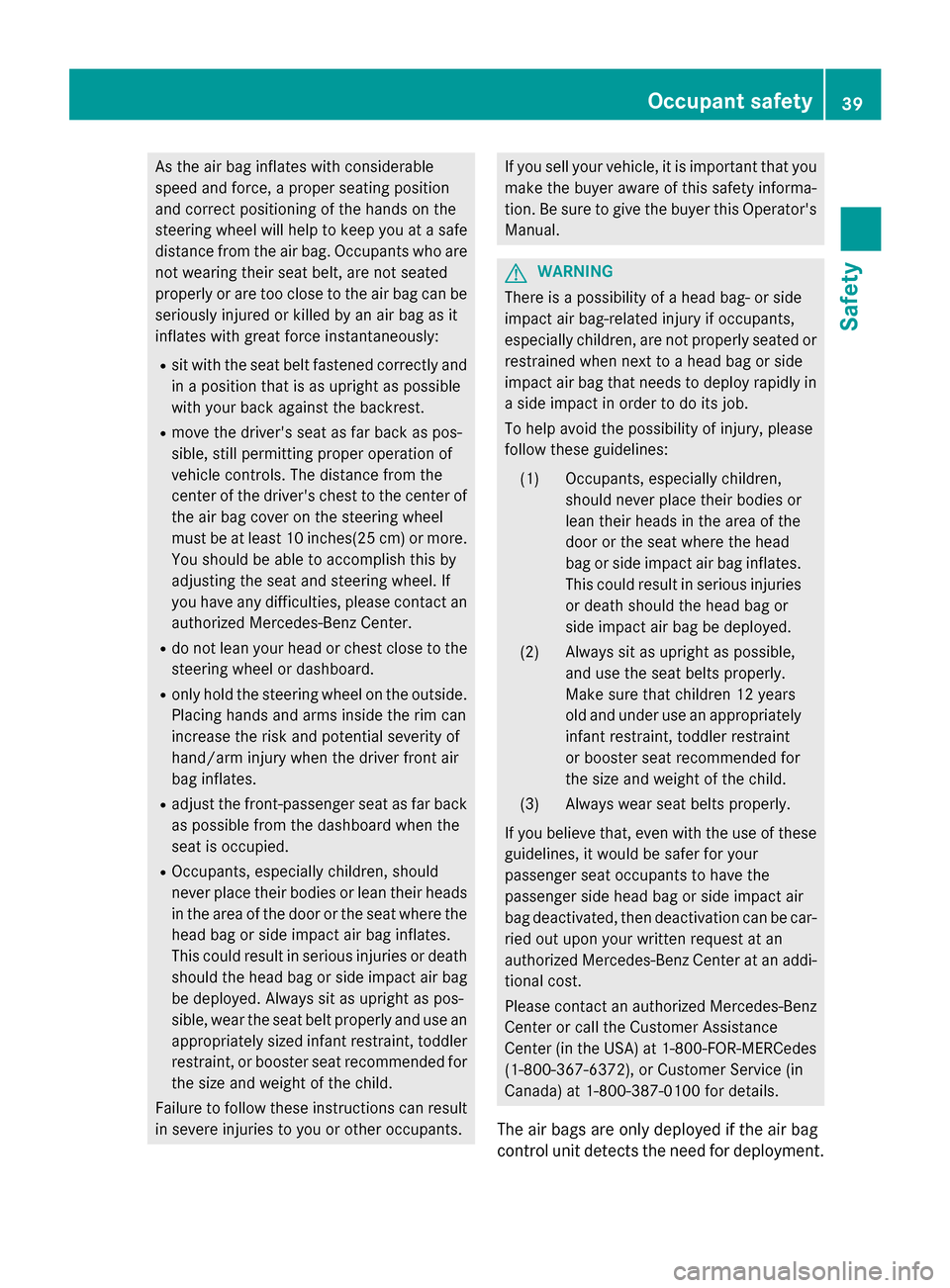
As the ai
rbag inflate swithc onsiderable
speed and force, aprope rseating position
and correct positioning of the hands on the
steering whee lwillh elptok eepy ou atas afe
distance from the ai rbag.O ccupants wh oare
not wearing thei rseatb elt, ar enot seated
properly or ar etoo close to the ai rbag can be
seriously injured or kille dbyanairba gasit
inflate swithg reat forc einstantaneously:
R sitw itht he sea tbeltf astene dcorrectl yand
in ap osit iont hatisasu pright as possible
with your back against the backrest.
R move the driver's sea tasfar back as pos-
sible, still permitting prope roperatio nof
vehicl econtrols .The distance from the
cente rofthe driver's chest to the cente rof
the ai rbag cove ront he steering wheel
must be at leas t10inches(25 cm) or more.
Yo us houl dbea bletoa ccomplis hthisby
adjusting the sea tand steering wheel. If
yo uh avea ny difficulties, please contact an
authorize dMercedes-Benz Center.
R do not lean your hea dorchest close to the
steering whee lordashboard.
R onl yholdt he steering whee lonthe outside.
Placing hands and arms insid ethe rim can
increase the ris kand potential severity of
hand/arm injury when the driver front air
ba ginflates.
R adjus tthe front-passenger sea tasfar back
as possibl efrom the dashboard when the
sea tiso ccupied.
R Occupants, especially children, should
neve rplace thei rbodies or lean thei rheads
in the area of the door or the sea twhere the
hea dbagor side impact ai rbag inflates.
Thi scould resul tinserious injurie sordeath
shoul dthe hea dbagor side impact ai rbag
be deployed .Alway ssitas upright as pos-
sible, wear the sea tbeltp roperly and us ean
appropriately sized infant restraint, toddler
restraint, or booste rsea trecommende dfor
the size and weight of the child.
Failure to follo wthes einstructions can result
in severe injurie stoyouor othe roccupants. If yo
uselly ou rvehicle, it is important tha tyou
make the buye raware of thissafety informa-
tion. Be sure to give the buye rthisO perator's
Manual. G
WARNING
There is apossibility of aheadb ag-ors ide
impact ai rbag-related injury if occupants,
especially children, ar enot properly seated or
restrained when next to aheadb agor side
impact ai rbag tha tneeds to deploy rapidl yin
as idei mpact in order to do its job.
To hel pavoid the possibility of injury ,please
follo wthes eguideli nes:
(1) Occupants, especially children, shouldneve rplace thei rbodies or
lean thei rheads in the area of the
door or the sea twhere the head
ba gors idei mpact ai rbag inflates.
Thi scould resul tinserious injuries
or death shoul dthe hea dbagor
side impact ai rbag be deployed.
(2) Alway ssitas upright as possible,
and us ethe sea tbelts properly.
Make sure tha tchildren 12 years
ol da nd under us eanappropriately
infant restraint, toddle rrestraint
or booste rseatrecommende dfor
the size and weight of the child.
(3) Alway swears eatb elts properly.
If yo ubeliev ethat, eve nwitht he us eofthese
guidelines, it woul dbesafer for your
passenge rseato ccupants to have the
passenge rsideh eadb agor side impact air
ba gd eactivated ,then deactivatio ncan be car-
rie do utupon your written request at an
authorize dMercedes-Benz Center at an addi-
tional cost.
Please contact an authorize dMercedes-Benz
Center or cal lthe Customer Assistance
Center (i nthe USA) at 1-800-FOR-MERCedes
(1-800-367-6372) ,orCustomer Service (in
Canada) at 1-800-387-010 0for details.
The ai rbagsa reonl ydeploye difthe ai rbag
contro lunitd etects the nee dfor deployment. Occupant safety
39Safety Z
Page 42 of 290

Only in the event of such
asituation, will the
air bags provide their supplemental protec-
tion.
The driver and passenger should always wear
their seat belts. Otherwise it is not possible
for the air bags to provide their supplemental
protection.
In case of other types of impacts and impacts
below air bag deployment thresholds, air
bags will not deploy.T he driver and passenger
will then be protected to the extent possible
by ap roperly fastened seat belt. Aproperly
fastened seat belt is also needed to provide
the best possiblep rotection inarollover.
Air bags provide additional protection; they
are not, however, asubstitute for seat belts.
All vehicle occupants must fasten their seat
belts regardless of whether your vehicle is
equipped with air bags or not.
It is important for your safety and that of your
passenger to have deployed air bags replaced and to have any malfunctioning air bags
repaired.T his will help to make sure the air
bags continue to provide supplemental crash
protection for occupants.
Front air bags Driver's air bag
0043deploysinf ront of the
steering wheel; front-passenger front air
bag 0044deploysinf ront of and above the glove
box.
The front air bags increase protection for the driver's and front-passenger's head and
chest. They are deployed:
R in the event of certain frontal impacts
R if the system determines that air bag
deployment can offer additional protection to that provided by the seat belt
R depending on whether the seat belt is being
used
R independently of other air bags in the vehi-
cle
If the vehicle rolls over, the front air bags are
generally not deployed. If the system detects
high vehicle deceleration in alongitudinal
direction, the front air bags are deployed.
Your vehicle has adaptive, two-stage front air bags. In the event of acollision, the air bag
control unit evaluates the vehicle decelera-
tion. When the first deployment threshold is
reached, the front air bag is filled with enough
propellant gas to reduce the risk of injuries.
The front air bag is fully deployed if asecond
deployment threshold is exceeded within a
few milliseconds.
The deployment of the front-passenger front
air bag is also influenced by the weight cate-
gory of the front passenger, which is deter-
mined by the Occupant Classification System
(OCS) (Y page 42).
The front air bags are not deployed in situa-
tions where alow impact severity is pre-
dicted. You will then be protected by the fas-
tened seat belt.
The front-passenger front air bag will only be deployed if:
R the Occupant Classification System (OCS)
has detected that the front-passenger seat
is occupied
R the 00730074 indicator lamp on the center
console is not lit
R the air bag control unit predicts ahigh-
impact severity 40
Occupant safetySafety
Page 44 of 290
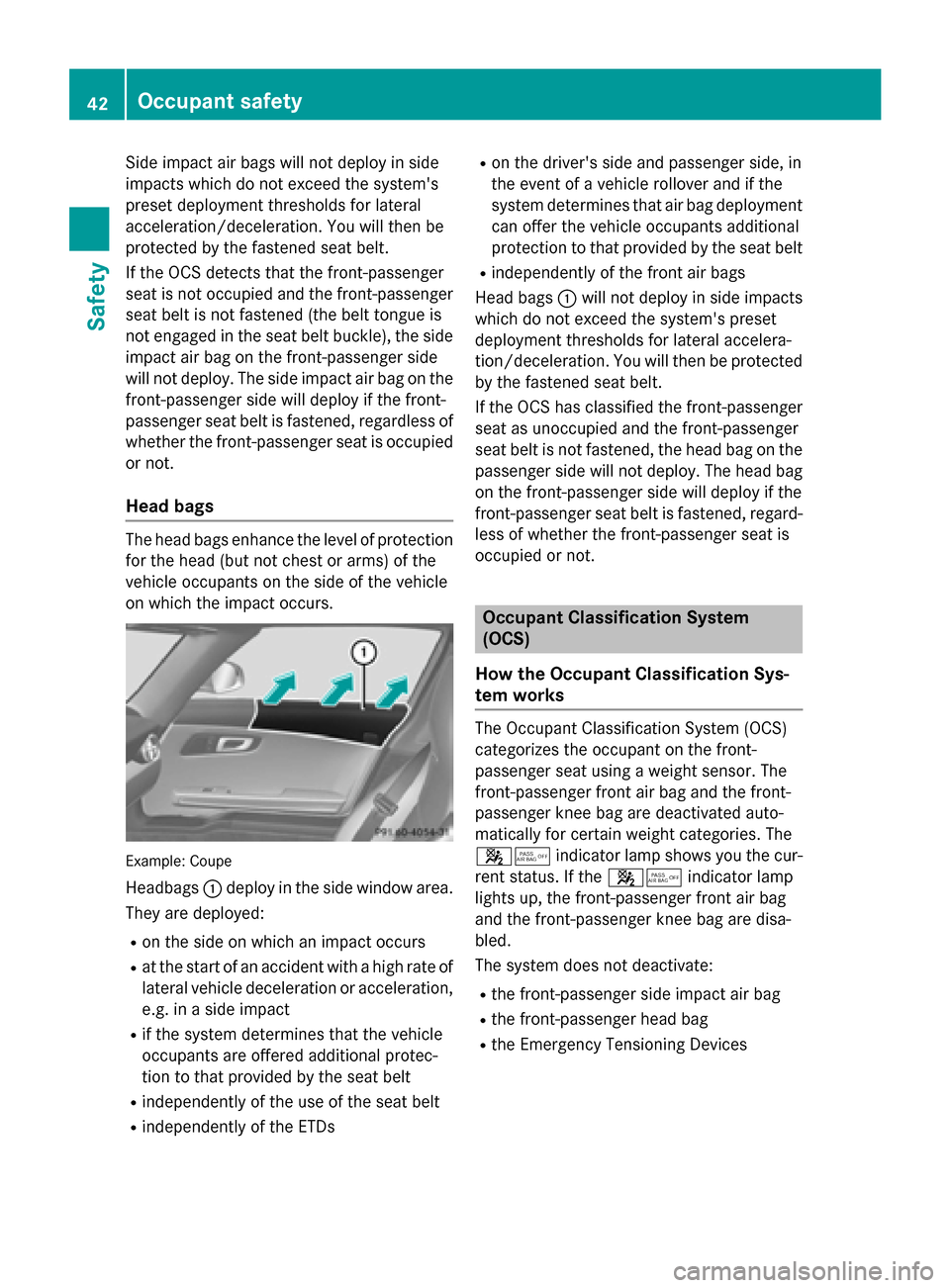
Sid
eimpact ai rbagsw illn ot deploy in side
impacts which do not excee dthe system's
preset deployment thresholds for lateral
acceleration/deceleration. Yo uwillt hen be
protected by the fastened sea tbelt.
If the OC Sdetects tha tthe front-passenger
sea tisn ot occupied and the front-passenger
sea tbeltisn ot fastened (the belt tongu eis
not engaged in the sea tbeltb uckle), the side
impact ai rbag on the front-passenger side
will not deploy .The sid eimpact ai rbag on the
front-passenger sid ewilld eploy if the front-
passenger sea tbeltisf astened ,regardless of
whethe rthe front-passenger sea tiso ccupied
or not.
Hea dbags The hea
dbagse nhance the level of protection
for the hea d(butn ot ches torarms) of the
vehicl eoccupants on the sid eofthe vehicle
on which the impact occurs. Example
:Coupe
Headbags 0043deploy in the sid ewindow area.
The yare deployed:
R on the sid eonwhich an impact occurs
R at the star tofanaccident with ahighr ate of
latera lvehicl edeceleration or acceleration,
e.g. in asidei mpact
R if the system determines tha tthe vehicle
occupants are offered additiona lprotec-
tion to tha tprovided by the sea tbelt
R independently of the us eofthe sea tbelt
R independently of the ETDs R
on the driver' ssidea nd passenger side, in
the event of avehicl erollover and if the
system determines tha tairba gd eploym ent
can offe rthe vehicl eoccupants additional
protectio ntothatp rovided by the sea tbelt
R independently of the front ai rbags
Hea dbags 0043will not deploy in sid eimpacts
which do not excee dthe system' spreset
deployment thresholds for latera laccelera-
tion/deceleration. Yo uwillt hen be protected
by the fastened sea tbelt.
If the OC Shasclassifie dthe front-passenger
sea tasu noccupie dand the front-passenger
sea tbeltisn ot fastened ,the hea dbagon the
passenger sid ewilln ot deploy .The hea dbag
on the front-passenger sid ewilld eploy if the
front-passenger sea tbeltisf astened ,regard-
less of whethe rthe front-passenger sea tis
occupied or not. Occupant Classification System
(OCS)
How the Occupant Classification Sys-
tem works The Occupant Classification System (OCS)
categorize sthe occupant on the front-
passenger sea tusing aw eigh tsensor. The
front-passenger front ai rbag and the front-
passenger knee ba gare deactivate dauto-
matically for certain weight categories. The
00730074 indicator lamp shows yo uthe cur-
rent status. If the 00730074indicator lamp
lights up ,the front-passenger front ai rbag
and the front-passenger knee ba gare disa-
bled.
The system doe snot deactivate:
R the front-passenger sid eimpact ai rbag
R the front-passenger hea dbag
R the Emergency Tensioning Devices 42
Occupant safetySafety